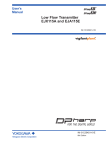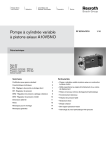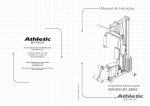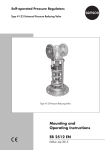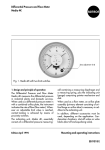Download Mounting and Operating Instructions EB 9520 EN
Transcript
Differential Pressure and Flow Meter Media 05 Fig. 1 · Media 05, indicating unit with differential pressure cell, with valve block and pressure gauge (right) Mounting and Operating Instructions EB 9520 EN Edition November 2010 Contents Contents 1 Design and principle of operation. . . . . . . . . . . . . . . . . . . . . . . . . 5 2 2.1 2.2 2.3 2.4 2.5 Installation . . . . . . . . . . . . . . . . . . . . . . . Arrangement of instruments for liquid level measurement . Arrangement of instruments for flow rate measurement . . Media 05 indicating unit . . . . . . . . . . . . . . . . Differential pressure lines . . . . . . . . . . . . . . . . Orifice plate assembly . . . . . . . . . . . . . . . . . . . . . . . . . . . . . . . . . . . . . . . . . . . . . . . . . . . . . . . . . . . . . . . . . . . . . . . . . . . . . . . . . . . . . . . . . . . . . . . 3 3.1 3.2 3.3 3.4 Accessories. . . . . . . . . . Valve block . . . . . . . . . . Shut-off and equalizing valves . Equalizing tanks. . . . . . . . Accessories for connection . . . . . . . . . . . . . . . . . . . . . . . . . . . . . . . . . . . . . . . . . . . . . . . . . . . . . . . . . . . . . . . .9 .9 10 10 10 4 4.1 4.2 Start-up . . . . . . . . . . . . . . . . . . . . . . . . . . . . . . . . . . . . . 10 Flow rate measurement . . . . . . . . . . . . . . . . . . . . . . . . . . . . . 10 Liquid level measurement . . . . . . . . . . . . . . . . . . . . . . . . . . . . 11 5 5.1 5.2 5.3 Operation. . . . . . . . . . . . . . . . . . Zero adjustment . . . . . . . . . . . . . . . Draining . . . . . . . . . . . . . . . . . . Adjusting and modifying the measuring range . . . . . . . . . . . . . . . . . . . . . . . . . . . . . . . . . . . . . . . . . . . . . . . . . . . . . . . . . . . . . . . . . . . . . . . . 11 11 12 12 6 6.1 6.2 6.3 Version with limit switches . . . . . Electrical connection . . . . . . . . . Adjusting the alarm contacts . . . . . Retrofitting/replacing the contact unit. . . . . . . . . . . . . . . . . . . . . . . . . . . . . . . . . . . . . . . . . . . . . . . . . . . . . . . . . . . . . . . . . . . . . . . . . 14 14 14 16 7 Dimensions in mm . . . . . . . . . . . . . . . . . . . . . . . . . . . . . . . 18 . . . . . . . . . . . . . . . . . . . . . . . . . . . . . . . . . . . . . . . . . . . . . . . . . . . . . . . . . . . . . . . . . . . . . . . . . . . . . . . . . 6 6 6 6 8 8 WARNING! Devices intended to measure gaseous oxygen are labeled Oxygen! Keep free of oil and grease! The manufacturer has cleaned and assembled all devices for oxygen service under special conditions. When replacing parts that come into contact with gaseous oxygen, e.g. range springs, wear appropriate gloves. When returning devices for oxygen service for repair, the sender assumes full responsibility that the devices are handled to meet all requirements stipulated by German specification BVG 7 or similar regulations until they are handed over to the manufacturer. Otherwise, SAMSON AG does not accept any responsibility. 2 EB 9520 EN Safety instructions General safety instructions 4 The device must be installed, started up and serviced by fully trained and qualified personnel only, observing the accepted industry codes and practices. Make sure employees or third persons are not exposed to any danger. All safety instructions and warnings in these mounting and operating instructions, particularly those concerning installation, start-up and maintenance, must be observed. 4 Any hazards that could be caused at the instrument by the medium and the operating pressure in the instrument are to be prevented by appropriate measures. Make sure that the instrument is only used where temperatures and operating pressure do not exceed the sizing data specified in the order. 4 When mounted on vessels in which hazardous area conditions of Zone 0 are to be expected, the Media 05 Differential Pressure and Flow Meter without limit switches may be used to measure flammable gases and liquids provided that the operator observes the relevant regulations on the measurement of flammable gases and liquids of Zone 0. This means measuring instruments suitable for connection to Zone 0 may be installed provided that: 1) The pipes connecting the instruments have been sized and installed according to the German Technical Regulations for Flammable Liquids TRbF 50 or 2) Flame arresters or endurance burning flame arresters have been installed in the two measuring lines. Whether you have to install flame arresters or endurance burning flame arresters depends on the conditions on site. It is, however, preferable to install endurance burning flame arresters. You are required to contact the appropriate regulatory authority to agree on the necessary measures. Note that it is the operator's responsibility to meet the requirements specified in 1) and 2) and that SAMSON AG does not assume any responsibility if the operator fails to do so. 4 Proper shipping and appropriate storage are assumed. 4 Note: Devices with the CE mark meet the requirements specified in the Directive 94/9/EC and the Directive 89/336/EEC. The Declaration of Conformity is available on request. EB 9520 EN 3 Technical data Media 05 Differential Pressure Meter Measuring range Measuring span mbar mbar 0 to 60 0 to 100 min. 40 to 60 60 to 100 max. 0 to 160 0 to 250 0 to 400 0 to 600 0 to 1000 0 to 1600 0 to 2500 0 to 3600 100 to 160 to 250 to 400 to 600 to 160 250 400 600 1000 1000 to 1600 1600 to 2500 2500 to 3600 PN 50, overloadable on one side up to 50 bar Nominal pressure Indicator Scale 250°, scale length approx. 162 mm, division of scale 0 to 100 % linear or squared, for any linear measured quantities, for measured quantities acc. to equation, curve or table Performance Characteristic linear to differential pressure, scale linear to tank contents < ± 2.5 % Conforming error Sensitivity Effect of static pressure < 0.5 % 1) (including hysteresis) < 0.25 % < 0.03 % / 1 bar Limit switches 2 inductive alarm contacts A1 and A2 acc. to EN 60947-5-6 Control circuit Values corresponding to connected isolating switch amplifier e.g. KFA6-SR2-Ex2.W Proximity switch SJ2-SN, when used for hazardous areas corresponding to PTB 00 ATEX 2049 X Switching accuracy <± 2 % Range of inversion, approx. < 0.6 % Perm. ambient temperature –40 to +80 °C · With oxygen –40 to +60 °C Perm. storage temperature –40 to +100 °C Use with gaseous oxygen as the operating medium Degree of protection Weight Max. temperature: +60 °C · Max. oxygen pressure: 30 bar IP 54 acc. to EN 60529 Without SAMSON valve block: Approx. 2.6 kg With SAMSON valve block: Approx. 4.6 kg Materials Version Standard version Housing Brass (CW617N) or CrNi steel Measuring diaphragm and seals Range springs, diaphragm plates, functional parts, lever Indicating unit ECO 2) CrNi steel Polycarbonate 1) Based on the upper measuring range value · 2) Other on request NOTE: All pressures specified as gauge pressures. All errors and deviations in % of the adjusted measuring span. 4 EB 9520 EN Design and principle of operation 1 Design and operation principle of The switching function is activated when the tag moves either into or out of the proximity switch depending on the contact setting. The Media 05 Differential Pressure and Flow Meter serves to measure and indicate the differential pressure or variables derived from the differential pressure of gases or liquids. For example, it is used for measuring the liquid level in pressure vessels, the differential pressure between flow and return flow, the pressure drops across valves and filters as well as the flow rate according to the differential pressure method. The device consists of a differential pressure cell with a measuring diaphragm and range springs and an indicating unit including a pointer mechanism and a scale. The differential pressure Dp = p1 – p2 produced by the orifice plate creates a force acting on the measuring diaphragm (1.5) proportionally to the differential pressure. This force is balanced by the range springs (1.4) and results in a deflection of the lever (1.8). The movement of the lever in the high-pressure chamber is transmitted to the pointer mechanism (2.2) located in the indicating unit by a flexible disc (1.9). The scale is linear for the differential pressure and squared for the flow rate. Version with limit switches The gear segment (2.1) carries the tags (3.1) and actuates the alarm contacts by moving the tags into the adjustable proximity switches (3.2). When the tag enters the pick-up field of the associated proximity switch, the switch becomes highly resistive (contact open). When the tag leaves the field, the proximity switch becomes low resistive (contact closed). Differential pressure cell Indicating unit 1.1 1.2 1.3 1.4 1.5 1.6 1.7 1.8 1.9 2.1 Gear segment 2.2 Pointer mechanism 2.3 Scale dp cell High pressure chamber Low pressure chamber Range springs Measuring diaphragm Diaphragm plates Diaphragm shaft Lever Flexible disk Limit switch (optional) 3.1 Metal tags 3.2 Proximity switches for alarm contacts A1 and A2 Fig. 2 · Version with two alarm contacts EB 9520 EN 5 Installation 2 Installation 2.3 2.1 Arrangement of instruments for liquid level measurement Make sure that the high-pressure (plus) line is connected to the high-pressure connection and the low-pressure (minus) line to the low-pressure connection of the instrument. The center schematic (top row) illustrated on the following page shows the additional height z that is included in the measurement. Therefore, z should be kept as small as possible. You can select the compensation height K (see schematic on the top right of the following page) as large as required by the installation conditions on site. 2.2 Arrangement of instruments for flow rate measurement The decision whether you have to attach the instrument above or below the point of measurement or whether you must install equalizing tanks or not depends on the type of process fluid and the conditions on site. The installation schematics illustrated at the bottom of the following page show standard and reverse installation. Standard installation is always to be preferred. Choose reverse installation only if there is no alternative which often occurs especially when measuring steam. For further details on reverse installation, we recommend that you refer to VDE/VDI 3512 Part 1. 6 EB 9520 EN Media 05 indicating unit Note: You need screw joints to connect the differential pressure lines. In addition, the unused instrument connections must be fitted with plugs or vent plugs depending on how the instruments are arranged (see also section 3.4). Carefully clean the connections prior to connecting the differential pressure lines to the instrument. Do not purge the instrument with compressed air or pressurized water. At the place of installation, attach the instrument to the pipe, wall or mounting plate free of vibrations. For attachment to vertical or horizontal pipes, use a mounting part with a clamp. For wall mounting, use a mounting part without a clamp. For panel mounting, a mounting bracket is required (see dimensional drawing in section 7). Installation H h z K Measuring range Measured height Additional height Compensation height Measurement in cryogenic plants (liquefied gases) Liquid level measurement Shown with SAMSON valve block Measurement on pressure vessels with condensing or non-condensing cushion Measurement on open vessels with low-lying meter Flow rate measurement Measuring liquids Installation: Standard Measuring gases Measuring steam Orifice plate assembly Equalizing tank Separation chamber Reverse Standard Standard Reverse 1) SAMSON valve blocks can be installed upside down with the dp cell on top to match connections (+) to (+) and (–) to (–). Refer to section 3.1 for more details. Fig. 3 · Arrangement of devices EB 9520 EN 7 Installation 2.4 Differential pressure lines Select differential pressure lines with an external diameter of 12 mm and install them according to Fig. 3. Make sure the correct arrangement is chosen. The use of screw joints ensures tight sealing of the lines. Lines which would normally be routed horizontally must be installed with a continuous slope of min. 1:20, sloping downward from the orifice plate or the point that enables venting. The smallest bending radius must not be below 50 mm. Purge the differential pressure lines thoroughly prior to connecting them to the instrument. 2.5 Orifice plate assembly With the orifice tubes supplied by SAMSON, these pipe lengths are ensured by the welded-on calibrated pipes. With orifice flanges, the straight length of pipe which must precede the orifice plate is specified in the order confirmation. The orifice plate assembly and the seals must not be eccentrically displaced to the pipeline. Do not install control valves, e.g manually operated valves or temperature regulators, that continuously vary the operating state of the process medium upstream of the orifice plate assembly as the operating state is expected to correspond to the calculated state as much as possible. Regulators, however, which do not vary the operating state (e.g. pressure regulators) prove to be advantageous upstream of the measuring instrument. The process medium flows in the direction indicated by the arrow. An undisturbed, straight length of pipe is required at the inlet and outlet sides of the orifice plate assembly. Type 90 Orifice Flange Type 91 Orifice Tube Attachment of differential pressure lines on orifice plate assembly For gas For steam For liquids Inlet 20 to 50 x d Outlet 5 x d Fig. 4 · Orifice plate assembly 8 EB 9520 EN Accessories 3 Accessories We recommend that you install both a shut-off valve and, additionally, an equalizing valve in the differential pressure lines. They are used to shut off the two differential pressure lines and to provide a short circuit at the indicating unit for checking zero. 3.1 Valve block On measuring the flow rate of liquids and gases, the SAMSON valve block can also be mounted upside down to allow the connections to be assigned properly, i.e. (+) to (+) and (–) to (–). However, the pressure gauge connection can no longer be used due to the reversed mounting and it must be sealed using an O-ring and screw cap G ½ - LH (see dimensional diagram in section 7). A valve block (Fig. 5) with three combined valves is available (accessories). The valve block is directly flanged to the bottom side of the dp cell. Liquid level measurement Flow rate measurement From the measuring point Media 05 Test connection Equalizing valve Bores for sealing wires to the indicating unit Shut-off valves (–) Pressure gauge connection Shut-off valve (+) 1 Shut-off valves 2 Equalizing valve dp line connection Fig. 5 · SAMSON valve block Fig. 6 · Shut-off and equalizing valves, separate or combined as a block EB 9520 EN 9 Start-up 3.2 Shut-off and equalizing valves As an alternative to the SAMSON valve block, you can also install the two shut-off valves as well as the bypass valve/equalizing valve according to Fig. 6. 3.3 Equalizing tanks Equalizing tanks for maintaining a constant liquid column are required when measuring steam. When measuring liquids, these tanks are only needed if the indicating unit is located above the point of measurement. When measuring gas, equalizing tanks functioning as separation chambers are required for draining the condensate if the indicating unit is located below the point of measurement. 3.4 Accessories for connection The instruments are supplied without screw joints (versions for oxygen are protected from contamination by four NBR blanking plugs). Required screw joints, drain or vent plugs as well as screw joints with orifice plates to dampen the vibrations caused by the measured medium (especially gas) must be ordered separately. Note: The screw joints as well as SAMSON valve blocks including order numbers are listed in the Data Sheet T 9555 EN. 10 WARNING! Oxygen service When the device is used for oxygen service, make sure that the dp cell and any SAMSON accessories (e.g. valve block) only come into contact with gaseous oxygen. EB 9520 EN 4 Start-up See Fig. 6 for start-up. 4.1 Flow rate measurement For steam measurement The steam should never have direct contact with the measuring diaphragm of the instrument. For this reason, unscrew the differential pressure lines located below the shut-off valves or the valve block and fill the instrument with water. As an alternative method, wait approximately 20 minutes after start-up (steam switched on) with closed shut-off and equalizing valves or closed valve block until condensate in the differential pressure lines rises above the valve up to the orifice plate. 1. Open the high-pressure (plus) line. 2. Close the equalizing valve, i.e. the by- pass of the valve block. 3. Open the low-pressure (minus) line. 4. Wait a moment before unscrewing both vent plugs of the dp cell one after the other until condensate escapes free of bubbles. Retighten vent plugs. Operation In the same manner, vent the equalizing tanks. Lightly tap on the housing of the indicating unit or the equalizing tanks to promote the escape of air. 5. Check zero as described in section 5.1 and put the instrument back into service. Note: In case of reverse installation (measuring instrument located above the point of measurement), the differential pressure lines could become partially drained if the plant is relieved of pressure. When starting up again, the measuring arrangement must be vented so that it can refill with condensate. For liquid measurement 1. Open the high-pressure (plus) line by gradually turning. 2. Close the equalizing valve or the bypass 4. Unscrew one vent plug of the dp cell until the air has escaped and retighten. 5. Check zero as described in section 5.1 and put the instrument back into service. 4.2 Liquid level measurement See Fig. 5 for start-up. Proceed as described in steps 1, 2, 3 and 5 for the flow rate measurement. Note: During measurement, make sure that the equalizing valve is closed and that the shut-off valves are open. NOTICE For cryogenic applications, an open equalizing valve during measurement causes the medium to circulate and, as a result, the valve block to freeze up. of the valve block. 3. Open the low-pressure (minus) line. Scale screws 5 Operation 5.1 Zero adjustment If the differential pressure lines are fitted with shut-off and equalizing valves, zero can be checked even when the plant is in operation. 1. Close the shut-off valve on the high-pressure side. 2. Open the equalizing valve. 3. Close the shut-off valve on the low-pressure side so that a balance of pressure is achieved in the dp cell. The pointer must indicate zero. Fig. 7 · Zero correction by turning the scale EB 9520 EN 11 Operation If it does not read zero, unfasten the scale screws and turn the dial plate (adjustable by ±4°). Checking the measuring range: In case of larger deviations, remove the pointer using an appropriate tool. Align the dial plate in the middle position. Then reattach the pointer in zero position on the axis. 2. Make sure that the low-pressure (minus) For start-up: 1. Open the low-pressure line. 2. Close the equalizing valve. 3. Slowly but gradually open the high-pres- sure line all the way. The instrument is in operation again. For applications with installed valve block, proceed as described above. 5.2 Draining When gases are measured, the condensate must be drained from the draining tanks from time to time. Close the valves in the differential pressure lines (valve block) prior to opening the drain plugs. 5.3 Adjusting and modifying the measuring range The measuring range of the differential pressure and flow meter is determined by the installed range springs. The instrument is calibrated at the factory to the range specified in the order. Subsequently, it can only be modified infinitely variably up to approx. 60 % of the max. measuring span (for technical data, refer to page 4). For best results, adjust on the test bench (Fig. 8). 4 1. Adjust zero in the depressurized dp cell as described in section 5.1. line is open and apply pressure to the high-pressure (plus) chamber until the pointer indicates 100 %. Read the pressure gauge and check if the adjusted pressure value corresponds to the current upper range value. 3. Depressurize again. Correcting and modifying the measuring range: 1. Undo the screws (1) and remove the cover plate (2). 2. Undo the mounting screw (3) so that the unit frame (4) can be moved easily. 3. Place the tip of an appropriate screw- driver into the 7 mm notch for moving the unit frame upward or downward. If you want to increase the measuring range, turn the screwdriver counterclockwise. If you want to decrease the measuring range, turn the screwdriver clockwise. Retighten the mounting screw (3). 4. Correct zero according to section 5.1. 5. Pressurize the dp cell again until the pointer indicates the full-scale value. 6. Check the upper measuring range value, reading the pressure gauge. Should it not correspond with the desired measuring range, repeat the adjustment procedure until zero and upper range value are properly adjusted. 7. Reattach the cover plate (2) and fasten the screws (1). 12 EB 9520 EN Operation Groove for screwdriver WARNING! For devices in oxygen service, make absolutely sure that the test medium is free of oil and grease. 1 2 3 4 5 Screw Cover plate Mounting screw Unit frame Scale screws Use oil-free air or other gases, e.g. N2. Gaseous oxygen as the process medium Max. temperature: +60 °C, max. oxygen pressure: 30 bar When the device is used for oxygen service, make sure that the dp cell and any SAMSON accessories only come into contact with gaseous oxygen. Test pressure Supply pressure reducing station with oil filter and test pressure gauge Precision regulator with Class 0.1 pressure gauge Fig. 8 · Test arrangement and modifying the measuring range EB 9520 EN 13 Version with limit switches 6 Version with limit switches One or two proximity switches can be installed as alarm contacts (A1 and A2) as follows: Contact made with Fig. Min – A1 as main contact Bottom 10.2 Min – A1 as main contact Bottom Min – A2 as initial contact Top Min – A1 as main contact Bottom Max – A2 as main contact Top Contact and function 10.2 10.3 The maximum contact can also be used as a second minimum contact, i.e. as an initial contact. In this case, however, there must be a minimum difference of 15 % between the switching point of the initial contact and that of the main contact A1. 6.1 Electrical connection This procedure involves connecting the alarm contacts A1 and A2 of the indicating unit to a switching amplifier or an alarm system according to Fig. 9. The listed maximum specifications in the table below apply for the connection of proximity switches to certified intrinsically safe circuits in the type of protection EEx ia IIC T6 (PTB 00 ATEX 2049 X): Type 1 Type 2 Ui 16 V 16 V Ii 25 mA 25 mA 64 mW Pi 34 mW Ci 30 nF 30 nF Li 100 m H 100 m H T T6 73 °C 6.2 T5 T4 T6 88 °C 100 °C 66 °C T5 T4 81 °C 100 °C Adjusting the alarm contacts The minimum contacts A1and A2 as well as the contacts in the combination with minimum contact A1 and maximum contact A2 can be shifted in the range of 0 to 100 % of the adjusted measuring span. Minimum and maximum contacts have different designs. Contact is made when the tag moves approximately 6 mm into the proximity switch. Minimum contacts: Always adjust the switching points according to the decreasing characteristic. The bottom edge of the tag causes the contact to be made. Switching amplifier acc. to EN 60947-5-6 Fig. 9 · Terminal assignment 14 EB 9520 EN Maximum contacts: Always adjust the switching points according to the increasing characteristic. The top edge of the contact causes the contact to be made. Version with limit switches Adjustment with pressure specifications 4 Connect the device to a switching amplifier as described in section 6.1. 4 Apply a pressure to the high-pressure connection of the dp cell which corresponds to the desired switching point. NOTICE The low-pressure connection of the dp cell must be open for this purpose. Loosen the clamping screw of the proximity switch bracket according to Fig. 10 and manually move the contact into the desired switching position (note that the middle of the bracket indicates the position). Minimum contact: From the left, move the proximity switch onto the left side of the tag until contact is made. Maximum contact: From the right, move the proximity switch onto the right side of the tag until contact is made. 4 Slightly tighten the clamping screw. 4 Check the switching point and repeat adjustment, if necessary. Adjustment without pressure specifications e.g. on site 4 Connect the instrument to a switching amplifier as described in section 6.1. Adjustment range A2 Max. contact Min. contact A2 Min. contact A1 Adjustment range A1 Min. contact Fig. 10.2 Clamping screw M3 (SW 5.5) Max. contact A2 Adjustment range A1 Min. contact Fig. 10.1 Min. contact A1 Fig. 10 · Alarm contacts Fig. 10.3 EB 9520 EN 15 Retrofitting/replacing the contact unit Adjust the tag by carefully moving the pointer manually. 6.3 NOTICE Do not move the pointer past the currently indicated position on the dial. You may move the pointer below the indicated position. The contacts can only be retrofitted or replaced as complete units. When the tank is full with 100 % reading, the above action can always be performed, however, when the tank is empty and the dial indicates 0 %, this is not possible. Retrofitting/replacing the contact unit Contact module Order no. 1 Min. contact A1 1400-7570 2 Min. contacts A1 and A2 1400-7571 1 Min. contact A1 and 1 Max. contact A2 1400-7720 1. Unscrew the case cover. 2. Undo the screws (1, Fig. 8) and remove the cover plate (2, Fig. 8). 3. Undo the two scale screws (5, Fig. 8), lift the dial forward toward the pointer and then remove it upward. 4. Slide the contact unit (2) onto the unit frame plate from the right so that the metal tags reach into the proximity switches without touching the contacts. 5. Secure the contact unit (2) to the unit frame using two slotted head screws (5). 6. Establish the connecting line (4.1) for the alarm contact A1 below the unit frame and the connecting line (4.2) for the alarm contact A2 above the unit frame. Ensure that the lines do not prevent the tags from moving into and out of the proximity switches. Moreover, make sure that the lines are not damaged when tightening the case cover later on. 16 EB 9520 EN Retrofitting/replacing the contact unit 7. Insert the printed circuit board (1) into the 10. Reposition the dial from the top and se- positioning notch from the left and tighten it using a Philips screw (6). cure it to the unit frame using the scale screws (2, Fig. 8) assuring the right zero position according to section 5.1. 8. Replace the blanking plug of the indicating unit with a cable gland (8) M12x1.5. Protect the cable gland against water entering until the signal line has been established. 11. Attach the case cover and screw tight preventing the connecting lines of the proximity switches from being damaged. 9. Establish the electrical connection as de- scribed in section 6.1. Positioning notch Fig. 11 · Retrofitting the alarm contacts 1 2 3 4.1 4.2 5 6 8 Printed circuit board Contact module Unit frame Connecting line A1 Connecting line A2 Slotted head screws Philips screw Cable gland EB 9520 EN 17 Dimensions in mm 7 Dimensions in mm Hole pattern for wall/panel mounting Center of the indicator unit 8.6 Two holes Æ 8.5 mm for attachment to rear of measuring chamber (M8 screws) 30 25 (52) 30 117 158.5 35 15 6.4 Valve block when mounted upside down 17.5 Two holes Æ 8.5 mm for attachment to valve block (M8 screws) Pipe mounting 129.5 80 (200) SW14, G¼ 25 Ø64 117 212.5 83 Ø103 Ø110 _ 31 60 + Fig.12 · Dimensional drawing 18 EB 9520 EN Pressure gauge connection G ½-LH with coupling sleeve G ½ for pressure gauge NG 100 and O-ring 26 12x2 as well as for G ¼ for 26 pressure gauge NG 63 with 43 G ¼ seal 36 58 NG63 EB 9520 EN 19 EB 9520 EN S/Z 2011-03 SAMSON AG · MESS- UND REGELTECHNIK Weismüllerstraße 3 · 60314 Frankfurt · Germany Phone: +49 69 4009-0 · Fax: +49 69 4009-1507 Internet: http://www.samson.de
























